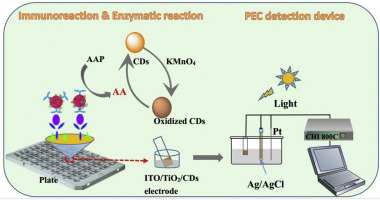当前位置:
X-MOL 学术
›
Anal. Chim. Acta
›
论文详情
Our official English website, www.x-mol.net, welcomes your
feedback! (Note: you will need to create a separate account there.)
Switched photoelectrochemistry of carbon dots for split-type immunoassay
Analytica Chimica Acta ( IF 5.7 ) Pub Date : 2018-07-01 , DOI: 10.1016/j.aca.2018.02.028 Yu-Ting Gong , Fang Yuan , Yuming Dong , Zaijun Li , Guang-Li Wang
Analytica Chimica Acta ( IF 5.7 ) Pub Date : 2018-07-01 , DOI: 10.1016/j.aca.2018.02.028 Yu-Ting Gong , Fang Yuan , Yuming Dong , Zaijun Li , Guang-Li Wang

|
A novel and general strategy of split-type immunoassay is developed based on redox chemical reaction modulated photoelectrochemistry of carbon dots (CDs). Specifically, the photocurrent of the CDs sensitized titanium dioxide nanoparticles (TiO2 NPs) modified fluorine doped indium tin oxide (FTO) (that is the FTO/TiO2/CDs) electrode was inhibited obviously by KMnO4 due to the oxidation of surface hydroxyl groups of CDs to electron accepting carbonyls. While the inhibited photocurrent of the KMnO4 treated FTO/TiO2/CDs electrode can be restored by ascorbic acid (AA) because of the regeneration of electron donating hydroxyls to promote electron-hole separation. Take carcinoembryonic antigen (CEA) as a model analyte and alkaline phosphate (ALP) as a catalytic label tracer to hydrolyze ascorbic acid 2-phosphate (AAP) for producing AA, which greatly stimulated the photocurrent of the transducer of KMnO4 treated FTO/TiO2/CDs photoelectrode for signal output. This redox chemical reaction modulated PEC strategy enabled the separation of the immunoreaction from the photoelectrode (that is, a split-type PEC detection), eliminating potential damage of biomolecules during the PEC detection processes and leading to enhanced throughput detection as compared to conventional PEC configurations. A low detection limit of 7.0 fg/mL was achieved for CEA. This convenient, split-type PEC immunoassay with high throughput may be easily extended to other bioaffinity assays for versatile targets.
中文翻译:

用于分体式免疫测定的碳点的开关光电化学
基于氧化还原化学反应调制的碳点 (CD) 光电化学开发了一种新的、通用的分体式免疫分析策略。具体而言,由于CDs表面羟基的氧化,KMnO4明显抑制了CDs敏化二氧化钛纳米颗粒(TiO2 NPs)修饰的掺氟氧化铟锡(FTO)(即FTO/TiO2/CDs)电极的光电流到电子接受羰基。而 KMnO4 处理的 FTO/TiO2/CDs 电极的抑制光电流可以通过抗坏血酸 (AA) 恢复,因为供电子羟基的再生促进了电子 - 空穴分离。以癌胚抗原(CEA)为模型分析物,以碱性磷酸盐(ALP)为催化标记示踪剂水解抗坏血酸2-磷酸(AAP)产生AA,这极大地刺激了 KMnO4 处理的 FTO/TiO2/CDs 光电极的换能器的光电流,用于信号输出。这种氧化还原化学反应调制的 PEC 策略使免疫反应与光电极分离(即分离型 PEC 检测),消除了 PEC 检测过程中生物分子的潜在损伤,与传统 PEC 配置相比,提高了检测通量. CEA 达到了 7.0 fg/mL 的低检测限。这种方便的分体式 PEC 免疫分析具有高通量,可以轻松扩展到其他生物亲和分析,用于通用目标。这种氧化还原化学反应调制的 PEC 策略使免疫反应与光电极分离(即分离型 PEC 检测),消除了 PEC 检测过程中生物分子的潜在损伤,与传统 PEC 配置相比,提高了检测通量. CEA 达到了 7.0 fg/mL 的低检测限。这种方便的分体式 PEC 免疫分析具有高通量,可以轻松扩展到其他生物亲和分析,用于通用目标。这种氧化还原化学反应调制的 PEC 策略使免疫反应与光电极分离(即分离型 PEC 检测),消除了 PEC 检测过程中生物分子的潜在损伤,与传统 PEC 配置相比,提高了检测通量. CEA 达到了 7.0 fg/mL 的低检测限。这种方便的分体式 PEC 免疫分析具有高通量,可以轻松扩展到其他生物亲和分析,用于通用目标。
更新日期:2018-07-01
中文翻译:

用于分体式免疫测定的碳点的开关光电化学
基于氧化还原化学反应调制的碳点 (CD) 光电化学开发了一种新的、通用的分体式免疫分析策略。具体而言,由于CDs表面羟基的氧化,KMnO4明显抑制了CDs敏化二氧化钛纳米颗粒(TiO2 NPs)修饰的掺氟氧化铟锡(FTO)(即FTO/TiO2/CDs)电极的光电流到电子接受羰基。而 KMnO4 处理的 FTO/TiO2/CDs 电极的抑制光电流可以通过抗坏血酸 (AA) 恢复,因为供电子羟基的再生促进了电子 - 空穴分离。以癌胚抗原(CEA)为模型分析物,以碱性磷酸盐(ALP)为催化标记示踪剂水解抗坏血酸2-磷酸(AAP)产生AA,这极大地刺激了 KMnO4 处理的 FTO/TiO2/CDs 光电极的换能器的光电流,用于信号输出。这种氧化还原化学反应调制的 PEC 策略使免疫反应与光电极分离(即分离型 PEC 检测),消除了 PEC 检测过程中生物分子的潜在损伤,与传统 PEC 配置相比,提高了检测通量. CEA 达到了 7.0 fg/mL 的低检测限。这种方便的分体式 PEC 免疫分析具有高通量,可以轻松扩展到其他生物亲和分析,用于通用目标。这种氧化还原化学反应调制的 PEC 策略使免疫反应与光电极分离(即分离型 PEC 检测),消除了 PEC 检测过程中生物分子的潜在损伤,与传统 PEC 配置相比,提高了检测通量. CEA 达到了 7.0 fg/mL 的低检测限。这种方便的分体式 PEC 免疫分析具有高通量,可以轻松扩展到其他生物亲和分析,用于通用目标。这种氧化还原化学反应调制的 PEC 策略使免疫反应与光电极分离(即分离型 PEC 检测),消除了 PEC 检测过程中生物分子的潜在损伤,与传统 PEC 配置相比,提高了检测通量. CEA 达到了 7.0 fg/mL 的低检测限。这种方便的分体式 PEC 免疫分析具有高通量,可以轻松扩展到其他生物亲和分析,用于通用目标。











































 京公网安备 11010802027423号
京公网安备 11010802027423号